 W
WPastry is a dough of flour, water and shortening that may be savoury or sweetened. Sweetened pastries are often described as bakers' confectionery. The word "pastries" suggests many kinds of baked products made from ingredients such as flour, sugar, milk, butter, shortening, baking powder, and eggs. Small tarts and other sweet baked products are called pastries. Common pastry dishes include pies, tarts, quiches, croissants, and pasties.
 W
WThis is a list of pastries, which are small buns made using a stiff dough enriched with fat. Some dishes, such as pies, are made of a pastry casing that covers or completely contains a filling of various sweet or savory ingredients.
 W
WAlexandertorte, also known as Alexander Torte or Aleksander Torte, is a dessert that was conceived to commemorate a visit of Tsar Alexander III in Riga, today's capital of Latvia.
 W
WA bear claw is a sweet, yeast-raised pastry, a type of Danish, originating in the United States during the mid-1920s. In Denmark, a bear claw is referred to as kamme. The name bear claw as used for a pastry is first attested in 1915. The phrase is more common in Western American English, and is included in the U.S. Regional Dialect Survey Results, Question #87, "Do you use the term 'bear claw' for a kind of pastry?"
 W
WButterkaka, or systerkaka is a pastry composed of rolled buns. The buns are made in the usual way, similar to cinnamon rolls, by rolling out the yeast dough, adding the almond–cinnamon filling, rolling it up, and cutting the log into smaller rolls. These are laid beside each other, with one cut surface down, in a baking pan, and during the process of rising and baking, the buns stick together. Butterkaka is often garnished with vanilla custard and glaze.
 W
WCinnamon Roll Day falls on 4 October each year. It is an annual theme day created for marketing purposes in Sweden and Finland that was instituted in 1999 by Kaeth Gardestedt. At the time, she was a project manager for Home Baking Council (Hembakningsrådet) which was historically a trade group supported by yeast manufacturers, flour producers, sugar manufacturers, and margarine manufacturers, and is now supported by the Dansukker brand of sugar.
 W
WConejos, Conejitos, o Conejitos chilenos are traditional Chilean pastry similar to berliner, in that they are filled with crème pâtissière (custard), but not fried. The dough is made with flour, eggs, sugar, milk, leavening, and butter. The filling is made with corn starch, egg yolks, milk, sugar, and vanilla.
 W
WA cream horn is a pastry made with flaky or puff pastry, and whipped cream.
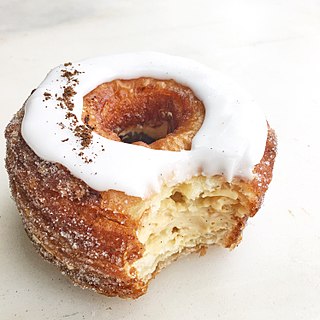 W
WThe Cronut is a croissant-doughnut pastry. It resembles a doughnut and is made from croissant-like dough which is filled with flavored cream and fried in grapeseed oil.
 W
WA cruffin is a hybrid of a croissant and a muffin. The pastry is made by proofing and baking laminated dough in a muffin mould. The cruffin is then filled with a variety of creams, jams, crème pâtissières or curds, and then garnished.
 W
WCuban pastries are baked puff pastry–type pastries filled with sweet or savory fillings.
 W
WDabby-Doughs are a type of pastry. They are traditionally made using the remnants of dough leftovers from making a pie, although they can be prepared in large amounts by simply making a batch of pastry dough. The filling of a dabby-dough is typically a mixture of cinnamon and white sugar sprinkled on butter or margarine, rolled, sliced and baked.
 W
WFigolla is a Maltese pastry stuffed with a marzipan-like filling and served as an Easter sweet. These are often shaped like hearts, crosses, stars, fish, any symbol which links to Christianity, particularly Catholicism, but in modern times these can be shaped into anything the person you give one to is passionate about.
 W
WFish-shaped pastry refers to the Japanese pastry Taiyaki, which is shaped to resemble a bream or Asian carp, and then is filled with red bean paste or other fillings like custard or chocolate. It is derived from the similar Japanese pastry called Imagawayaki. It is also popular in other East Asian countries such as: South Korea where it is known as bungeoppang.
 W
WFlaky pastry, also known as quick pastry, blitz pastry or rough puff, is a light and flaky unleavened pastry that is similar to, but distinct from, puff pastry. It is often called quick pastry or blitz pastry in reference to the short time its preparation requires.
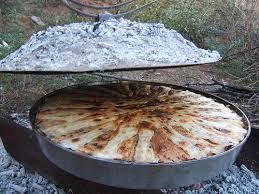 W
WFlia, also known as fli or flija, is a dish in and Albanian cuisine. It consists of multiple crêpe-like layers brushed with cream and served with sour cream. The name translates to "sacrifice".
 W
WGibanica is a traditional pastry dish popular all over the Balkans. It is usually made with cottage cheese and eggs. Recipes can range from sweet to savoury, and from simple to festive and elaborate multi-layered cakes.
 W
WGrand-pères, grand-pères au sirop d'érable or grand-pères dans le sirop d'érable is a traditional pastry in Québécois and Acadian cuisine. The term pépère is also used to describe this dish in some regions of Quebec like Beauce. This pastry is commonly served during "le temps des sucres" in sugar shacks.
 W
WGur cake is a pastry confection traditionally associated with Dublin, Ireland. Known as chester cake in other areas, and gudge or donkey's gudge in Cork, it is similar to what is termed flies graveyard in parts of the UK, and consists of a thick layer of filling between two thin layers of pastry. The filling is a dark brown paste, containing a mixture of cake/bread crumbs, dried fruits, and a sweetener/binder. It has traditionally been a cheap confection, made from bakery leftovers.
 W
WA Haitian patty is a baked puff pastry-type pastry filled with savoury filling.
 W
WHalloumoti / Hellimli is a Cypriot savoury pastry made with halloumi cheese.
 W
WHot water crust is a type of pastry used for savoury pies, such as pork pies, game pies and, more rarely, steak and kidney pies. Hot water crust is traditionally used for producing hand-made pies.
 W
WJambons are square pastries filled with cheese and chunks of ham. They are a ubiquitous deli item in Ireland. The product emerged during the 1990s as part of a broader movement towards "food to go". Twenty million jambons were purchased by Irish consumers in 2020, cementing it as Ireland's most popular comfort food.
 W
WA joulutorttu is a Finnish Christmas pastry. It is traditionally made from puff pastry in the shape of a star or pinwheel and filled with prune jam and often dusted with icing sugar. The pastries can be in other shapes and apple used in place of the prune jam.
 W
WThe Kitchener bun is a type of sweet pastry made and sold in South Australia since 1915. It consists of a bun sometimes baked, sometimes fried, made from a sweet yeasted dough similar to that used for making doughnuts, split and then filled with raspberry or strawberry jam and cream, most often with a dusting of sugar on the top.
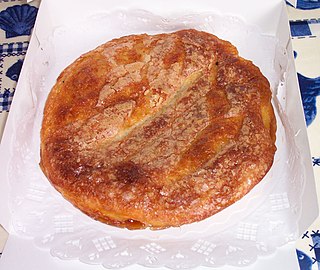 W
WKouign-amann is a sweet Breton cake, made with laminated dough. It is a round multi-layered cake, originally made with bread dough, containing layers of butter and incorporated sugar, similar in fashion to puff pastry, albeit with fewer layers. The cake is slowly baked until the sugar caramelizes and the recipe's butter expands the dough, resulting in its layered structure similar to a muffin-shaped, caramelized croissant.
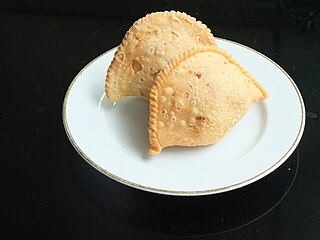 W
WIn Indonesia, pastel refers to a type of kue filled with meat, vegetables, and rice vermicelli deep fried in vegetable oil. It is consumed as a snack and commonly sold in Indonesian traditional markets. The similar Manadonese version replaces the thin crust with bread filled with spicy cakalang and is called panada.
 W
WLākhāmari is a type of sweet of Newars. It is made of flour, sugar, butter and other ingredients. It can be made in different shapes and are named differently depending upon the shapes. It is customarily given to guests of marriage ceremony in some Newar subculture. Prior to marriage, the groom has to provide 'lakhamari's to the bride's family, which they will send along with the invitation card for marriage. However, lakhamaris will only be sent to close relatives. Lakhamari can be stored in dry for many days.
 W
WLattice pastry is a pastry used in a criss-crossing pattern of strips in the preparation of various foods. Latticed pastry is used as a type of lid on many various tarts and pies. The openings between the lattice allows fruit juices in pie fillings to evaporate during the cooking process, which can caramelize the filling.
 W
WMalsouqa is a Tunisian dish composed of sheets of filo dough, stuffed with a savory filling.
 W
WMonkey bread is a soft, sweet, sticky pastry served in the United States for breakfast or as a treat. It consists of pieces of soft baked dough sprinkled with cinnamon. It is often served at fairs and festivals.
 W
WMouna, also known as Mona is an Algerian Jewish sweet bread of Sephardi origin, similar to challah, kubaneh or brioche, that is traditionally consumed for the Jewish holidays of Mimouna and Shabbat, which is commonly found today in France, and Israel, and has a sweet taste enriched with oil and eggs and often contains anise, sesame, orange, or other citrus.
 W
WThe pain à la grecque is a typical Brussels pastry consisting of a simple rectangle of milk bread, brown sugar, and cinnamon sprinkled with granulated sugar.
 W
WPain au chocolat, also known as chocolatine in the south-west part of France and in Quebec, or couque au chocolat in Belgium is a type of viennoiserie sweet pastry consisting of a cuboid-shaped piece of yeast-leavened laminated dough, similar in texture to a puff pastry, with one or two pieces of dark chocolate in the center.
 W
WA pastel is a typical Brazilian fast-food dish, consisting of half-circle or rectangle-shaped thin crust pies with assorted fillings, fried in vegetable oil. The result is a crispy, brownish fried pie. The most common fillings are ground meat, mozzarella, catupiry, heart of palm, codfish, cream cheese, chicken and small shrimp. Pastéis with sweet fillings such as guava paste with Minas cheese, banana and chocolate also exist. The pastel is classified in Brazilian cuisine as a salgado. It is traditionally sold on the streets, in open-air marketplaces, or in fast-food shops known as pastelarias. It is popularly said to have originated when Chinese people adapted their traditional "spring rolls" to the Brazilian taste, by using local ingredients. The recipe was later popularized by Japanese immigrants that during World war II tried to pretend to be Chinese to espace from the prejudice Japanese people were facing because of the Japanese alliance during the war. Another theory was that Japanese immigrants adapted Chinese fried wontons to sell as snacks at weekly street markets. A common beverage to drink with pastéis is caldo de cana, a sugarcane juice.
 W
WPastelitos de hoja is a Sephardic Jewish pastry originating in the Jewish community that formerly existed in Tetouan, Morocco.
A pastizz is a traditional savoury pastry from Malta. Pastizzi usually have a filling (tal-ħaxu) either of ricotta or curried peas. Pastizzi are a popular and well-known traditional Maltese food. It should not be confused with the Italian pastizz, better known as U' pastizz 'rtunnar.
 W
WThe peinirli is an elongated, open pie made in a boat shape. They contain a substantial amount of yellow cheese and, optionally, meats or vegetables. Peinirli originated in Turkey, where it is known as pide. There are two types of pide: peynirli pide, in which cheese entirely covers the surface of the filling, and karışık pide, which has cheese only as part of the filling.
 W
WPets de sœur, literally Nun farts, is a French-Canadian dessert that is made from pie dough; often from left over Tourtière dough, that is layered with butter, brown sugar and cinnamon, then rolled, sliced, placed in a pan, covered with additional brown sugar, covered in milk, and finally baked. Sufficient milk must be added such that it is not dry after the baking. It is called Pets de Soeur as it was served by Nun's at boarding schools in some parts of the province of Quebec. If milk is not added, then they should be called Nombrils de Soldats, literally Soldier navels, and not Pets de Soeurs. They are very similar to cinnamon rolls but are not leavened.
 W
WPop-Tarts is a brand of toaster pastries that the Kellogg Company introduced in 1964. Pop-Tarts have a sugary filling sealed inside two layers of thin, rectangular pastry crust. Most varieties are also frosted. Although sold pre-cooked, they are designed to be warmed inside a toaster or microwave oven. They are usually sold in pairs inside Mylar packages and do not require refrigeration.
 W
WPot pie is the North American term for a type of meat pie with a top pie crust consisting of flaky pastry. The term is used in North America. Pot pies may be made with a variety of fillings including poultry, beef, seafood, or plant-based meat substitute fillings, and may also differ in the types of crust. In the United States, both beef pot pie and chicken pot pie are the most popular types of pot pies and can vary significantly in terms of both preparation and ingredients.
 W
WPuff pastry, also known as pâte feuilletée, is a flaky light pastry made from a laminated dough composed of dough and butter or other solid fat. The butter is put inside the dough, making a paton which is repeatedly folded and rolled out before baking.
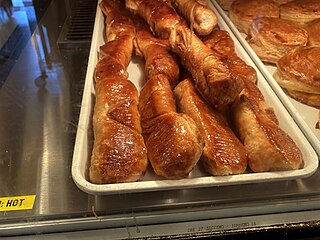 W
WQuesito is a cream cheese-filled pastry twist from Puerto Rico.
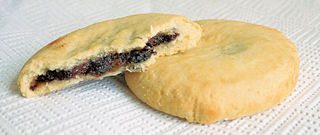 W
WChorley cakes are flattened, fruit filled pastry cakes, traditionally associated with the town of Chorley in Lancashire, England. They are a close relative of the more widely known Eccles cake, but have some significant differences. The Chorley cake is significantly less sweet than its Eccles cousin, and is commonly eaten with a light spread of butter on top, and sometimes a slice of Lancashire cheese on the side.
 W
WA samosa is a South Asian fried or baked pastry with a savory filling like spiced potatoes, onions, peas, chicken and other meats, or lentils. It may take different forms, including triangular, cone, or half-moon shapes, depending on the region. Samosas are often accompanied by chutney, and have origins in medieval times or earlier. Samosas are a popular entrée, appetizer, or snack in the local cuisines of South Asia. Due to emigration and cultural diffusion from these areas, samosas today are often prepared in other regions.
 W
WSeffa is a Maghrebi dish of sweetened semolina cuscus with butter, cinnamon, and almonds. It can also be made with rice or vermicelli. This dish is generally consumed at the end of a meal, before dessert. It is often served at traditional marriage ceremonies and family gatherings.
 W
WShortcake is a sweet cake or biscuit in the American sense that is a crumbly bread that has been leavened with baking powder or baking soda. In the UK, the term shortcake refers to a biscuit similar to shortbread. They are generally less dense and more crunchy and dry than shortbread.
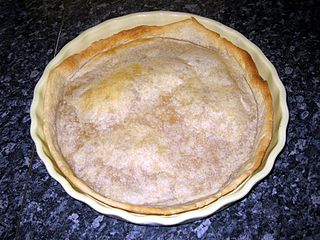 W
WShortcrust pastry is a type of pastry often used for the base of a tart, quiche or pie. Shortcrust pastry can be used to make both sweet and savory pies such as apple pie, quiche, lemon meringue or chicken pie.
 W
WToast'em Pop Ups is a Toaster pastry brand that was first produced by Schulze and Burch Biscuit Company, who also made peanut butter squares in 1964 similar to that of Pop-Tarts. The product has no trans fat, and Schulze and Burch Biscuit Company claims that the products have "extra fruit filling." The product's pastry and filling are said to have a "higher standard of production," and the company suggests that it has a 'state of the art' production facility.
 W
WA toaster pastry is a type of bakers' confection, and a convenience food. They are thin rectangles often made of rice bran, molasses, flour, syrup, and shortening, which on one side usually has a coating of icing that has been dried with starch. They contain sweetened liquid fillings, often fruit preserves or other flavoring ingredients such as chocolate or cinnamon. They may be heated in a toaster or oven before being eaten, however, it is not required; they are edible "raw", as they are precooked during the factory process.
 W
WToaster Strudel is a brand of toaster pastry convenience food currently owned by General Mills, prepared by heating the frozen pastries in a toaster and then spreading the included icing packet on top. The brand is historically notable for being stored frozen, due to innovations in 1980s food manufacturing processes.
 W
WA turnover is a type of pastry or bread made by placing a filling on a piece of dough, folding the dough over, sealing, and baking it. Turnovers can be sweet or savoury and are often made as a sort of portable meal or dessert. They are often eaten for breakfast.
 W
WA vanilla slice is a type of pastry. It consists of a thick custard, which is traditionally flavoured with vanilla or chocolate, and which is sandwiched between flaky puff pastry or filo pastry and iced with either vanilla, chocolate, strawberry, raspberry or passion fruit icing.